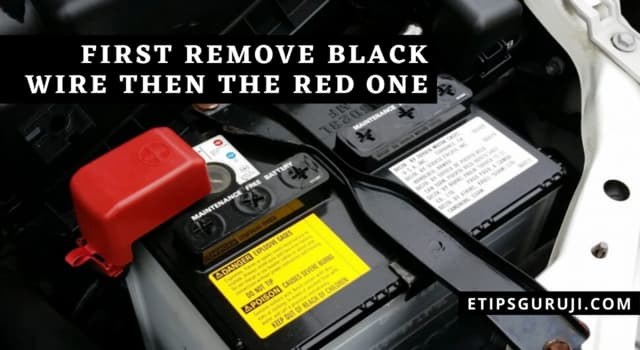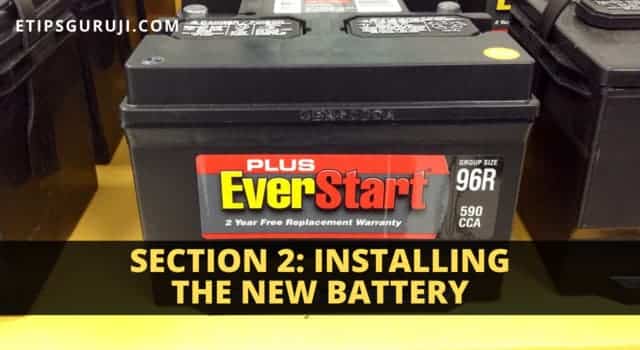How to Change a Car Battery? 13 Basic to Advance Tips

How to change a car battery: You may face a situation where your car refuses to start due to a dead battery. And now it’s time to replace it. But you didn’t want to lend money to the car mechanic, so you decided to change it by yourself. And this is what you are going to learn in this post.
So, in this article on “How to change a car battery?” we will give you a quick and step by step guidelines to cope with this situation by yourself.
How to Change a Car Battery?
Car Battery is a key component of the car that ignites the initial spark of the engine. In short, it is called to be the heart of the car. There are various companies that made car batteries, but the common thing in all car batteries is— they dead with time, especially when you are not using your car daily.
So, feel free to read this guide on “how to change a car battery?” if you don’t want to give your hard-earned money to mechanics. Moreover, if you recently installed a new car battery then there might be other reasons why won’t your car start. Check our dedicated post on “why won’t my car start?“
That’s enough for the introductory part, let’s move to the next big section of the post. Here, we split our topic of “How to change a car battery?” into two broad categories, so it might be easy for you to understand.
- Section 1: Removing the Old Battery
- Section 2: Installing a New Battery
Also Read:
- How to Hotwire a Car? | 3 Best-Known Cheat to Hotwire a Car
- Why Won’t My Car Start- 11 Basic Reason Along With Solutions
Section 1: Removing the Old Battery

This is the basic and first section of our topic on “how to change a car battery”, you just have to follow these pointers:
1. Keep the Vehicle Parked
First, you need to find a safe place to replace your car’s battery. You can park the vehicle in a safe area such as a garage or driveway to replace the car battery.
While parking your car, try to park the vehicle where you get natural light not under any dark covered area. These are some other pointers that you should take into account while parking a car:
- Park your car away from traffic, sparks, open flames, or water.
- Suppose you have parked your car on a sloping edge of the road, in that case, to avoid any slipping tires, you should use a wooden block or bricks in the front and rear tires of the car.
After parking the car, these are the following things that you should do before replacing the car’s battery:
- Turn off your vehicle and engage emergency brake or hand brakes.
- You should also remove the car keys from the ignition, to ensure that no aftershock would hit you while replacing the car battery.
- You may need to reset your radio, clock, navigation, and alarm settings or possibly a few other electronics when you’re disconnecting the battery. For this, you may need a memory saver.
2. Pop the Hood

Put on the safety gear and pop open the hood of the vehicle. And before going to change the battery, make sure the engine and surrounding car parts are cool enough. This is because the hot engine and its ventilator hot water can cause burns to your skin.
Moreover, normal car batteries contain a sulfuric acid electrolyte solution, which is highly corrosive, that can also capable to burn your skin, and produces flammable hydrogen gas.
So, these are some pointers that you should follow for your own safety while changing the car battery:
- Wear insulated work gloves and safety goggles
- Take off metal jewelry like a watch or ring, to avoid any electric shock
- To avoid getting greasy, you can use old clothes or a general lab coat.
3. Locate the battery
Finding a battery could be a nasty task if you are using high-end model cars. But in general scenarios, the car batteries are present in the trunk, under the hood, or elsewhere. In most cases, you may find the battery in a corner of the engine bay, either near the windshield or the front bumper on either side of the car.
You can also search for the rectangular battery box that can be easily distinguished by two attached cables. However, if you have a new car then the battery part might be in one component i.e. underneath a plastic cover, so remove the cover if necessary.
Note: If you are unable to find the battery then check your owner’s manual.
4. Identify Positive and Negative Battery Ends
Before going to disconnecting the cables you must identify positive and negative ends which can easily be distinguished by red and black cables— just like the wiring of your house.
So, you can easily identify the positive ends with red marking or red plastic cover or may have a plus sign (+), and negative ends with black markings or plastic cover or may have a minus sign (-) near it.
5. Disassemble the Black/Negative (-) Cable

Always disconnect the black wire cable before the positive cable. Why this? This will prevent you from getting any electric shock.
As stated earlier in this post of “how to change a car battery”, if necessary, remove the plastic cover. Now, you have to use a wrench to loosen the negative cable clamp nut and detach the negative cable from the battery.
While detaching and handling the negative terminal wire, try to follow these pointers:
- In general, you need a 7mm, 8mm, 10mm, or 13mm wrench to detach the cables from the battery.
- You can use a tape to cover and secure the detached black wire. This will ensure that it will don’t get in contact with other metal body parts.
- In the case of carbon deposition or trusting, detaching the wire from the battery could be hard. At that time you can use a battery terminal puller.
6. Disassemble the Red/Positive (+) Cable
Now to loosen the positive cable clamp or cables, disconnect the positive cable from the battery with a wrench, and secure it with electric tape. While dealing with the detached wiring from the battery, you should take these pointers into consideration.
- The positive and negative cables do not touch each other.
- Either end of the battery should not come in contact with any metals otherwise that cause dangerous electrical shock.
7. Remove the Battery from the Vehicle
Before removing the car battery from the vehicles, you should carefully inspect the brackets that hold the battery in place. After that, remove any connectors that hold the battery.
For this, you have to need a socket wrench of the right-size of the socket and an extension bar. After removing the sockets nuts, neatly pulls the battery out of the shielded container.
Safety Tips:
- Ensure that you firmly hold the battery. This is because, they can weight 5 to 10kg of the weight, depending upon the car type. So, try to use your both hands to pick the battery out of the car.
- While holding or picking the battery from the car, keep your hands steady and look for the adjacent space to avoid any injury while removing it.
- Avoid any agitation because it might cause the spilling of sulphonic acid from the battery.
- Always carefully pick the nuts of the battery container as it might fall into the car, which again adds extra work for you.
With this, our first section of removing the car battery from our topic of “how to change a car battery?” ends.
Section 2: Installing the New Battery

Our next section of “how to change a car battery” is installing the new battery. These are the following step by step guide to install a new battery.
1. Clean the Battery Connectors
With the use of a brush, which is designed to clean the inside of battery clamps and the outside of the terminals that stick up on the battery. This is a crucial thing before installing a new battery because it makes your new car battery to get free from any carbon deposition and rusting— hence a longer battery life.
To clean the connector, you can use a wire brush along with a solution of a mixture of baking soda and water. And if the clamps have the corrosive surface, you can use emery cloth or 100-grit sandpaper to remove it.
Note: Make sure everything must be dry before installing a car battery. Handle car batteries carefully because they are the acid batteries that might damage the contact clothing.
2. Buy the Right Replacement Battery
You should buy a correct battery that replaces the old one. You can either note the details form the older battery or you can check the owner car manual.
Try to look for the details such as size, dimensions, and part number from the old battery or even the year, make, model, and engine size of your vehicle. All these information will help you in buying a new battery for your car.
3. Insert the New Battery
Now it’s time to secure the bracket and insert the new battery into the battery tray. Re-install the clamp(s) in the same manner but in the reverse order. You should ensure that it fits the battery chamber like the older one.
These are a few important points that you should follow:
- Make sure the battery is kept in the same way as the old one.
- Check all the bolts on the bracket and secure it with the clamp. So the battery doesn’t vibrate or move around while you’re driving.
- Recycle the Used Battery: Do not throw battery because it contains corrosive material. Therefore, take the used batteries to a service or recycling center for disposal.
4. Apply an Anti-Corrosion Solution

After placing the battery to its position, its time to remove the red and black plastic covers or clamps that are present at the terminal of the battery and remove the taped area that you earlier used to cover them.
After removing the tapes, a thin layer of lithium greases on each of the terminals should be applied. This would ensure that your terminal end of the battery never catches serve corrosion. You can also use lithium anti-corrosion sprays to make this task easy.
Note: Do not spray the lithium grease on any other part of the engine other than the positive and negative terminals. You can also use cardboard as the base while spraying the lithium grease.
5. Reconnect the Cables
In installing the new battery in the car, you should first attach the positive cable or red cable to the battery followed by the negative terminal cable. Hook the cable up inside the cable connector area of the battery and tighten it down with a wrench.
Other important points that you should remember while reconnecting the terminal cable with battery are:
- Be careful not to touch any metal until you safely place them on the battery terminals, as this can cause a dangerous electrical discharge.
- If your battery has a plastic cover, replace it at this time.
- Double-check the connection and clamp area by slightly pulling the wire back and forth.
People Also Read:
- MOSFET Transistor: Basics, Working Principle, 2 Types & Uses
- How to Test Capacitors – Its Methods, Functions and Types
6. Close the Hood and Start your Vehicle
Before turning off the hood of the car, you should first start your car and check whether or not all of the equipment is working fine. After that reset your clock, radio, and navigation system.
You should also check all the equipment under the hood should be aligned to their place.
Here our topic on “how to change a car battery” ends. Now, we are going to discuss some of the most frequently asked questions that most users search on Google.
General FAQ
How long does it take to change a car battery?
Ans. To replace the car battery, it usually takes about 20 minutes. But sometimes some issues may take a few more minutes. These problems usually occur when the clamp that holds the battery may be corroded, or some batteries are located in difficult places.
Which battery terminal do you take off first?
Ans. To remove the old car battery, you must first take off the negative cable followed by the positive cable.
Can you change a car battery yourself?
Ans. Yes, you can easily change a car battery yourself by following the above section of our article on “how to change a car battery”.
Why is the negative terminal of a battery removed first and assembled last during engine maintenance?
Ans. Because the negative terminal of the battery is grounded to the body of the vehicle. If we first remove a positive terminal cable, there is a possibility of a spark or electric shock which might cause flames as there is a lot of combustible material around the car engine.
What size wrench do I need to change a car battery?
Ans. Depending on the vehicle, you may need a 7mm, 8mm, 10mm, or 13mm wrench to remove the cables. But most cars use a 10 mm (0.4 in), wrench or socket to replace the car’s battery.
Now, our topic of “How to change a car battery?” finally ends. These are some of the interesting topics that might interest you. So, feel free to browse our automobiles and technological categories.
